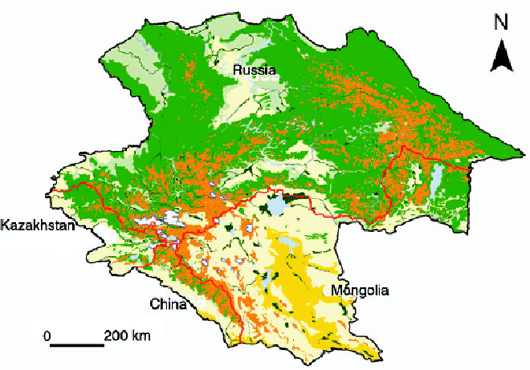Altai-Sayan Ecoregion
Contact Information
- Programme Leader for Altai-Sayan
WWF Russian Programme Office (Closed. Contact WWF Mongolian Programme Office)
Nikoloyamskaya 19/3
Moscow, Russia
Tel: 7-095-7270939
Fax: 7-095-7270938
cochir@wwf.ru
Lead Institution
World Wide Fund for Nature Russian Programme
Technical team
- Chimed-Ochir Bazarsad
- Alexander Bondarev
- Anatoliy Mandych
- Yuri Plusnin
- Veniamin Semenov
- Alexander Shestakov
- Vladimir Sokolov
- Svetlana Surazakova.
Timeframe
2003–2012.
Intended Audience
local, national and regional decision-makers.
Links (archived 2011 after WWF and WWF Russia cut ties)
www.wwf.ru
Updated Report 2012
Project Summary

The Altai-Sayan ecoregion is located in the territories of Russia, Mongolia,
Kazakhstan and China. It encompasses mountain pristine forest ecosystems,
surrounded by steppes in the north and east, and by deserts and semi-deserts
in the south and west. The region includes the Altai and Sayan mountain
systems and vast intermountain depressions. This region is one of the world
centers of plant diversity. Its biological, landscape, historical, cultural
and religious diversity is unique. There are many species of mammal, bird,
amphibian, fish and at least 213 species of rare and endemic plants. The
area is also culturally diverse, with four language groups (Russian, Mongolian,
Chinese and Turkic) and more than 20 indigenous ethnic groups practicing
traditional land use systems. There are also a variety of religions including
Christianity, Islam, Buddhism and Shamanism.
Biodiversity
The high value of ecosystems and biodiversity of the Altai-Sayan ecoregion
is fundamental in considering it one of the key Global 200 Ecoregions identified
by the WWF and recognized by the United Nations and World Bank (3,726 species
of vascular plants are registered in the region including 700 threatened
or rare species, 317 of which are endemic; fauna consists of 680 species,
6% of which are endemic). The ecoregion is the northern range of the natural
habitat of the snow leopard ( Uncia uncia ) and Altai mountain sheep argali
( Ovis ammon ammon ). Poverty, widespread unemployment, and a lack of alternative
economic activities are serious socioeconomic drivers that could negatively
impact the biodiversity of the Altai-Sayan. Exploitation and strain on natural
resources are increasing rapidly in the ecoregion. Protection of biodiversity
in the region also depends on the ability of the local communities to maintain
traditional land use patterns and practices.
Natural forests
The present-day condition of the main provisioning services—timber and
firewood—of forest ecosystems in the Altai-Sayan ecoregion overall is estimated
to be good. However, the condition is reduced to fair or even poor in some
localities that are under human pressure or where unsustainable use, including
illegal logging, is practised. In the foreseeable future, forest ecosystems
of the region will continue to provide people with the resources they demand,
while also continuing to provide other supporting and regulating services.
However, this will be sustainable in the long-term only if the state controls
the use of forest ecosystem services at current levels. The existing data
and modeling outputs are not sufficient to address questions about the impact
of climate change on forest ecosystems and related consequences for human
well-being. New studies on the impact of climate change on forest ecosystems
of the Altai-Sayan ecoregion are urgently required. In the recent decades,
the leading drivers of change in the region’s forest ecosystems have been
commercial logging and fire. Fire impacts will increase in the future, owing
to human activity, economic change, climate change, and pests.
Grazing lands of Western Mongolia
Overgrazing and overharvesting of biological resources (timber, wildlife)
in western Mongolia is a result of the impoverishment of the country’s population,
who have few livelihood options and who depend almost entirely on natural
resources. Mongolia’s transition to a market economy caused some adverse
effects on the state of the environment and grazing ecosystems. One of the
effects related to changes in grazing lands was caused by the cessation
of seasonal grazing, which has been practiced by Mongolian nomads for millennia.
Seasonal herding led to a distributed impact on all grazing lands of the
region. The abandonment of traditional herding practices was accompanied
by an increase of livestock concentrated close to settlements and water
sources. This caused overgrazing and even complete degradation of grazing
lands in some places. Based on the assessment of the current state and trends
of grazing ecosystems, it is possible to define priorities for social responses
to the current situation and future developments, including elements of
a social strategy related to the use of natural resources and sustainable
resource management.
Regional waters and climate change
Pronounced climate warming has been observed in the region in recent
decades, and has resulted in the Altai glaciers receding and shrinking.
In the case of the Katun River, which drains the northern slope of the Altai
high mountains, there was no increasing trend in the river’s runoff from
1950 to 2000. However, there was a noticeable trend of decreasing differences
between seasonal runoff in the high and low mountains of the Katun basin.
This is explained by the different responses of the rivers, with runoff
forming in different elevation zones according to seasonal changes in precipitation.
Currently the population and the economy have a much more significant impact
on the water quality of rivers and lakes than does climate change. An increase
in population and growth of the economy will likely cause rapid changes
in the condition of regional waters, especially through surface water pollution.
Environmental consciousness of rural populations
The rural population in Altai-Sayan is slowly moving from the utilitarian
and negative environmental paradigm of ‘‘extraction and utilization’’ towards
new ethical principles regarding the environment. People have become aware
of the need for environment protection and conservation. This is reflected
in public behavior (environmental protests, establishment of new environmental
NGOs), although it is still rare. It has also been observed in new economic
behavior and in the establishment of environmentally friendly businesses,
related to the sustainable use and regeneration of local resources. This
has taken place without the assistance and initiative of central authorities
or the mass media.